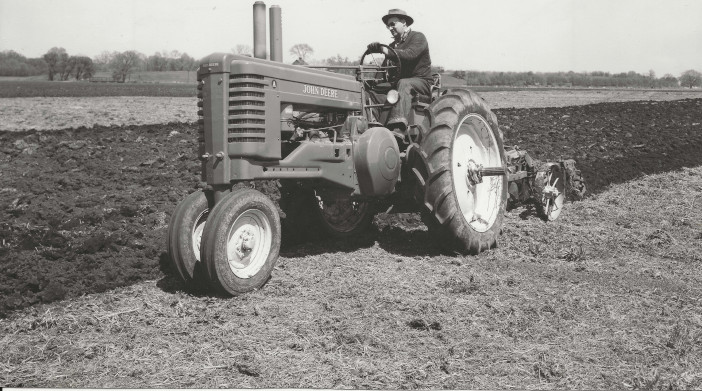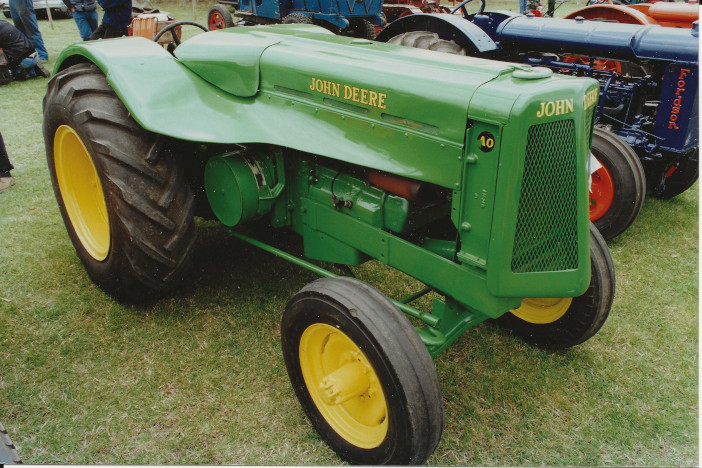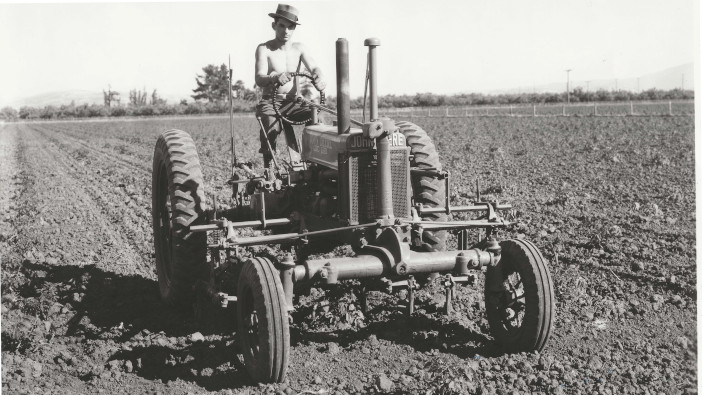The Model A made a major contribution to the early years of John Deere tractor success, introducing technical developments plus new styling. Mike Williams reports.
The John Deere company was almost 100 years old when the Model A arrived. The company was started in about 1837 by John Deere, who was born in America where his parents emigrated from England. He began his own business making and repairing equipment for local farmers after he had worked for a blacksmith for a few years to gain experience.
His new business was immensely successful, making mainly cultivation implements at first, and its rapid growth was helped by an improved plough design John Deere had developed. Production reached more than 800 ploughs and other implements per week by 1870, and by 1886 the annual production from the John Deere factory was more than 100,000 implements as America’s farming industry continued its rapid expansion.

Tractor development at John Deere started in 1912, with a small number being sold, but success did not arrive until 1918 when the Deere company bought an established manufacturer with an existing tractor range. The company they bought was the Waterloo Gasoline Engine Co making Waterloo Boy tractors, and Deere continued selling an improved version and retained the Waterloo Boy name while a new model was developed.
The new tractor was the John Deere Model D, available from 1923, and in 1927 it was joined by the Model C, the first John Deere row crop tractor. The Model C was updated in 1928, reappearing as the General Purpose or GP to complete the 1920s programme of new model introductions. The next new arrival from John Deere was the Model A available from 1934 when it replaced the General Purpose and introduced important design improvements.
Deere & Co’s success in establishing the new tractor range during the 1920s was an impressive achievement. There was intense competition in the early and mid-1920s following a big increase in the number of companies making tractors during and just after the World War 1 sales boom, and another problem was Henry Ford’s efficient production methods and aggressive price-cutting policy for his Fordson tractor, which helped to put many rival manufacturers in America and Europe out of business.
John Deere tractor success increased during the 1930s, helped by the arrival of the Model A with an engine producing 24.71hp maximum output and 16.31hp at the drawbar during its Nebraska tests. The engine design was two horizontal cylinders, a direct descendant of the engine Deere had taken over when it bought the Waterloo company in 1918. At that time tractors with single and twin-cylinder engine layouts were beginning to seem outdated and were increasingly replaced by four and occasionally six-cylinder engines. The obvious option for the new John Deere tractor being designed to replace the Waterloo Boy would be to follow the trend and switch to four-cylinder power, but instead they chose an updated version of the Waterloo company two-cylinder design.

A two-cylinder power unit probably seemed a surprising choice at the time, but it became one of the most successful engine series the tractor industry has produced, powering almost every new John Deere tractor built until 1960. One of the reasons for its popularity was the fact that engine reliability remained an important issue while many tractor customers were first-time buyers who had previously worked with horses. A two-cylinder engine design could offer potential reliability benefits, including fewer moving parts and easier access for routine maintenance.
Improvements introduced on the Model A and later on other John Deere tractors included a four-speed gearbox. This replaced the three speeds on the earlier Model C and General Purpose tractors, while the Model D had arrived in 1923 with only two forward speeds. Independent rear-wheel braking was included in the Model A specification, the rear wheels were mounted on a splined axle to simplify track width adjustment, and the design team improved the forward visibility from the driver’s seat.
The most advanced technical feature introduced on the Model A was the hydraulically operated implement lift option. This was not the Ferguson System three-point linkage with draft control that had recently made its first public appearance in 1933 on Harry Ferguson’s special prototype Black Tractor, but it was an advance on previous manually and mechanically operated systems, offering faster working speeds than the mechanical lift previously available from John Deere. It also included a ‘soft-drop’ action that cushioned the fall when lowering mounted equipment, and it earned the Model A’s place in power farming history as the first production tractor with hydraulic lift, narrowly ahead of the first Ferguson production tractor introduced in May 1936.
One of the design features that helped boost John Deere tractor sales was the fact that as well as the standard AR or ’A Regular’ tractors, the Model A was also available in a range of special versions for particular crop requirements. The special versions were identified by letters, and examples include the ‘narrow’ AN with a single front wheel and the AW for crops with wide row spacing. The AN and AW were also available in ‘high’ ANH and AWH versions with large diameter wheels to give extra clearance for tall crops, the AO versions were for orchard work and Industrial versions often featured a bright yellow paint finish.
When the last few Model A tractors left the factory early in 1953, it was the end of a production run that had lasted almost 20 years, and during this time there were various updates and improvements that included a new six-speed transmission based on a three-speed gearbox with hi-lo ratios almost doubling the maximum forward speed to 11 mph. Engine modifications in 1939 boosted the output to almost 29hp, and an electric kit including lights and engine starting was introduced in 1947.
The most eye-catching of the various developments on the Model A was new look styling in 1938. Mechanical features affecting reliability and performance were the priorities in the early years of tractor development, with manufacturers and their customers being less concerned about the tractor’s appearance, but styling and colour moved up the priority list during the 1930s, influenced by trends in the car industry where streamlining with more rounded shapes plus brighter paint colours was increasingly popular. John Deere had previously chosen their familiar green and yellow colours, but to update the shape of their tractors they employed Henry Dreyfuss, one of America’s foremost industrial stylists. The new look he produced arrived in dealers’ showrooms in 1938 on the Model A and some of the recently introduced Model B tractors, and was later adopted for other John Deere models. John Deere tractors built before the arrival of the Dreyfuss influence are referred to as ‘unstyled’ to distinguish them from the later ‘styled’ models.
Read more ‘Whatever Happened to’ features here


